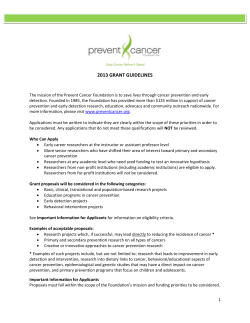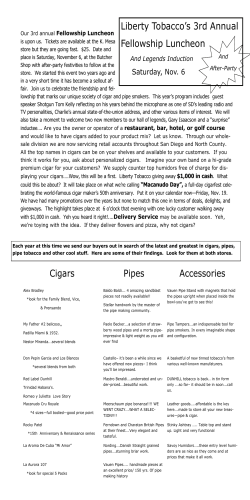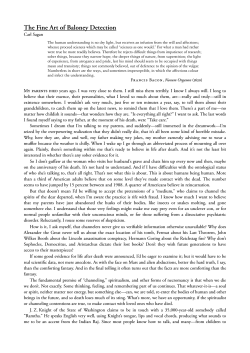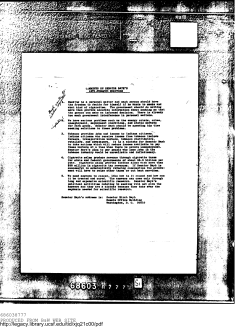
HOW TO MANUFACTURE PUBLIC DOUBT: by the Climate Denial Industry MARCH, 2009
HOW TO MANUFACTURE PUBLIC DOUBT: Analysis of the public relations techniques used by the Climate Denial Industry MARCH, 2009 *Updated for the Heartland Institute's 2009 “International Climate Change Conference” Introduction There is a long and well-documented history of the development of very effective public relations techniques that are used to create doubt about the realities of scientific conclusions that threaten to impose government regulation on corporations. Most of these techniques were developed and honed by public relations professionals working on behalf of the tobacco companies to downplay the harmful health effects of cigarettes in the late 80’s and early 90’s. For the last ten years or so, these same PR techniques have been used very effectively by free-market think tanks and fossil-fuel funded organizations to sow public doubt about the realities of climate change in the hopes of delaying government action on the issue. Project DeSmog’s team is comprised of communication and public relations professionals, writers, researchers and media experts. We have become a powerful participant in the Global Warming debate, working diligently to ensure that the public conversation remains on solid scientific ground. Our analysis is based on over 10 years of research starting with DeSmog writer Ross Gelbspan who wrote the book The Heat is on: the climate crisis, the cover up, the prescription in 1998 that first uncovered what we call the Climate Denial Industry. In late 2005, The DeSmog Project was formalized by a 25-year public relations professional, Jim Hoggan who was fed up with the PR spindoctoring he was seeing on the issue of climate change. You can go hear to read Jim’s original manifesto on the rational behind the formation of the DeSmog Project: Slamming the Skeptic Scam. Our website, DeSmogBlog.com, has played a powerful role in enabling us to become a recognized leading force in exposing and discrediting Global Warming public relations misinformation campaigns. THE CLIMATE DENIAL INDUSTRY The climate denial industry is a web of right-wing free market think tanks, ideologically motivated foundations and energy companies that have done a very good job at creating a widely held public perception that there remains serious doubt about the realities of climate change science and the conclusion that human-activity is to blame. Oil and coal companies have poured millions into this network of denial and this has allowed for the absolute proliferation in the number of think tanks and organizations that reinforce the message that, among many arguments, climate change is not happening and/or that human activity is not to blame and therefore individuals and governments need not do anything about it. Excerpt from a 1998 American Petroleum Institute document called the “Global Science Communications Plan” outlining a campaign to sow doubt about the scientific realities of climate change. HOW TO MANUFACTURE PUBLIC DOUBT What follows is an examination of the most common public relations techniques used by the climate denial industry to create doubt and delay action. - 1969 internal Brown and Williamson strategy paper Technique: Expert doubt There is a long history of using a technique first developed by the tobacco industry to prop up supposed “experts” that will provide contrary views on the scientific realities of climate change. You can trace the history of the tobacco lobbyists right into the energy lobbyists who use this technique to create doubt in the public mind about the certainty of scientific conclusions. Organizations like the Chicago-based Heartland Institute were involved in the tobacco campaigns to create expert doubt long before they were in the business of climate change. The Expert Doubt technique has been a mainstay for the climate denial industry. In fact a 1998 memo drafted for American Petroleum Institute (API) was uncovered that outlines a campaign to recruit and amplify in the media the opinions of expert doubters. Named in the memo are some of the high-profile members of the climate denial industry, including: •Steven J Milloy, the self-titled “Junkman” •Myron Ebbell, Competitive Enterprise Institute •Candace Candrall, Science and Environment Policy Project Continues… Excerpts from the 1993 paper titled “Revised Plan for the Public Launching of TASSC” Continues… Excerpts from the 1998 American Petroleum Institute document called the “Global Science Communications Plan” Continues… Technique: Astroturfing There’s a tobacco PR strategy paper that outlines this technique very well. The tobacco industry figured out quite early on that the public would not see credible an argument that is pro-tobacco coming from a tobacco executives mouth, so they created fake grassroots organizations that could defend their interests and maintain a certain appearance of being third-party, neutral organizations. So the tobacco lobby created a very well financed organization called The Advancement of Sound Science Coalition (TASSC). The goal of TASSC was to: While astroturf groups are the most desirable organization for industry campaigns, “independent” think tanks also can serve the same purpose, as they are also in a position of being once-removed from the corporation. Diversifying the target issues of an astro-turf can add even further to the appearance that the group is not simply an industry front. TASSC strategized that their organization would not gain credibility in the eyes of the public and news media if the only issue they focused on was tobacco, so they derived a list of other topics that threatened to impose government regulations that they could also fight against. At the top of their list was global warming. Continues… Excerpt of a TASSC memo discussing the diversification of issues Continues… Excerpt of a 1997 RJ Reynolds internal e-mail discussing an astroturf and Steve Milloy Continues… Excerpts from the 1998 American Petroleum Institute document called the “Global Science Communications Plan” mentioning astroturfers, Steve Milloy, Myron Ebell and Candace Crandall, wife of well-known climate denier Dr. S. Fred Singer Continues… Technique: Tortured Messaging When there is no solid evidence left, sometime the only option available is to twist and turn reality in an attempt to back your desired messaging (i.e. that climate change is hoax). Many times, you’ll see the same evidence scientists are using to reinforce their conclusions about the realities of climate change, turned on its head and used to argue the exact opposite. Example: “Since 1998, the earth’s temperature has been cooling” – the reason 1998 was an exceptionally hot year was due to a very warm and sustained El Nino. Every year since then has been cooler, but the overall trend still shows that there has been a continuing upward trend in global temperatures, they just haven’t been as warm as the spike in 1998 (except for 2005 which NASA reported as the hottest year on record). In fact, the last decade has been warmer than anytime in recorded history and while there is evidence that these warming trends may remain level for a while, scientists are insistent in their conclusion that this upward trend will continue aggressively after this leveling off phase. So the same evidence scientists are using to reinforce the need to act now to reduce greenhouse gas emissions is being used by the climate denial industry as an excuse to do nothing. You can read more on this here: Hot or Not - making sense of climate variability Technique: Echo chamber This technique plays on the old adage that if you repeat something often enough it becomes the truth. The idea is to take the tortured messaging and the expert doubt and then push it hard with media and online sources very quickly before there is a chance for others to correct the misinformation. - Excerpt from the 1998 American Petroleum Institute document called the “Global Science Communications Plan” Technique: Message Shaping Most public relations people know that you need to test and constantly re-test messaging, using such things as opinion polling and focus groups, to ensure that your message resonates with your target audience and also creates the desired perception. Over time you re-shape your message to stay in tune with the accepted social norms of the times. This practice is rather innocuous when used to sell widgets, but it is a whole different ball game when it’s used to sow doubt about an important issue like climate change. The climate denial industry has done a good job of tailoring its messaging to fit the public sentiment at a given time in history. Over the last decade or so we’ve seen three distinct phases in the climate denial industry’s efforts to delay personal and government action: Phase 1: Global warming will be a benefit to the planet and humans In the beginning phases of the Kyoto Protocol negotiations the Western Fuels Association led a very aggressive campaign arguing that global warming would be a benefit to agriculture and the world’s food crops. This took the form of an organization called the “Greening Earth Society.” The Greening Earth Society was a non-profit set up by the Western Fuels Association, a co-op organization for the transport of coal to electrical generation plants. Continues… Screenshot of the now defunct “Greening Earth Society” Phase 2: Global warming is a hoax This is the phase that we are in right now, but slowly transitioning to the 3rd phase. The best way to describe the “global warming is a hoax” phase is that this argument was identified by public opinion researchers as the most effective way to delay action on the issue of climate change. It would create a sense of doubt in people’s minds about what scientists were concluding on the issue. It is easier to create doubt, than it is to change people’s minds entirely, so the climate denial industry used the techniques we described above (expert doubt, astroturfing and echo chamber) to create the necessary doubt. This campaign of doubt used the techniques mastered by the tobacco lobby when it was trying to convince the public and government that tobacco smoke was not as harmful as the scientists were saying it was. Continues… Excerpts from a 1995 strategy document prepared by opinion researcher Frank Luntz for the Republican Party Continues… Phase 3: The economic frame With a US president taking the issue of climate change very seriously, an ever-growing body of evidence making it more and more clear the realities of climate change and the international community getting set to enact a new international treaty, it has become a lot more difficult to argue that climate change is a hoax – there’s just too many forces aligned against this argument. The more savvy in the climate denial industry have now turned to the final play which is to argue that while climate change may be happening and may be caused by humans, it is just too expensive to do anything about it. The economic frame is completely disingenuous when you see the same people who were telling us a year ago that climate change was a hoax now saying it’s not, but we still shouldn’t do anything about it. Continues… Excerpts from a 1995 strategy document prepared by opinion researcher Frank Luntz for the Republican Party Additional resources We hope you found this report useful and pass this on to others so they too will be aware of the techniques being used to mislead and confuse the public on one of the most important issues we’ve ever faced. Here’s some further reading on the climate denial industry that you might be interested in: DeSmogBlog co-founder Jim Hoggan’s popular Manifesto “Slamming the Skeptic Scam” http://www.desmogblog.com/slamming-the-climate-skeptic-scam PDF version of the Luntz Memo: http://www.desmogblog.com/sites/beta.desmogblog.com/files/Luntz%20Memo.pdf PDF version of the API’s Global Climate Science Communications Plan: http://www.desmogblog.com/sites/beta.desmogblog.com/files/API%20Global%20Climate%20Science%20Communica tions%20Plan.pdf PDF version of the Plan for the Public Launching of TASSC: http://www.desmogblog.com/sites/beta.desmogblog.com/files/revised%20plan%20public%20launching%20of%20tass c.pdf Slate article on the emerging agreement on the economics of climate change mitigation: http://www.thebigmoney.com/articles/hey-wait-minute/2009/02/11/surprise-economists-agree Report: King Coal And Big Oil Unite To Buy The Future, Spending More Than Two Million Dollars A Day: http://wonkroom.thinkprogress.org/2008/08/19/coal-and-oil-unite/ Continues… 2003 Guardian Newspaper article on the Luntz Memo: http://www.guardian.co.uk/environment/2003/mar/04/usnews.climatechange “Energy Debate Heats Up” a San Francisco Chronicle article describing the “Green Earth Society” http://www.sfgate.com/cgi-bin/article.cgi?file=/chronicle/archive/2000/08/14/BU70391.DTL 2007 Union of Concerned Scientists Report: Smoke, Mirrors & Hot Air: How ExxonMobil Uses Big Tobacco's Tactics to "Manufacture Uncertainty" on Climate Change http://www.ucsusa.org/global_warming/science_and_impacts/global_warming_contrarians/exxonmobil-report-smoke.html Exxon Secrets: a database exposing ExxonMobil’s funding of the climate denial industry: http://www.greenpeace.org/usa/campaigns/global-warming-and-energy/exxon-secrets Contact Information: Kevin Grandia, Operations Manager Phone: 778.240.6343 Email: [email protected] Feel free to contact us anytime with any information you think might interest us or for media inquiries To keep up to date on our latest activities and research consider signing up for our weekly newsletter here: http://www.desmogblog.com/newsletter
© Copyright 2025













